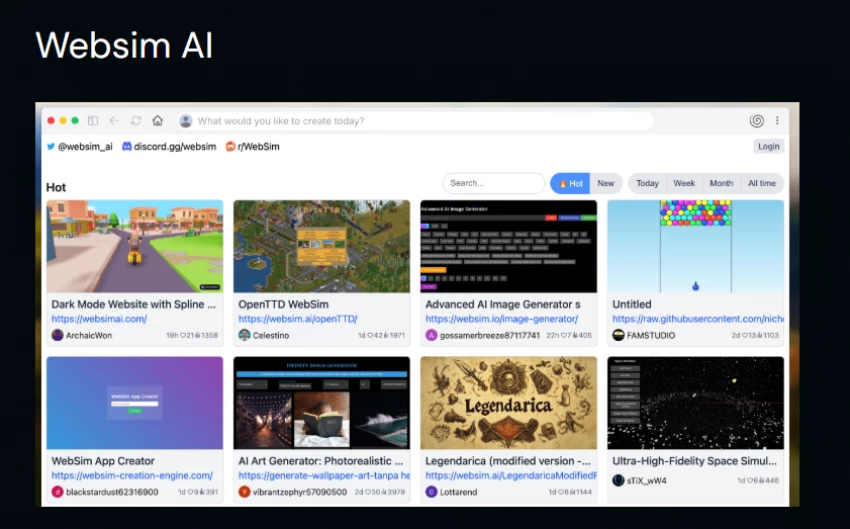

For years, having a cool idea for a game or website wasn’t enough. If you didn’t know HTML, CSS, or JavaScript, your ideas often stayed stuck in notebooks or whiteboards. Hiring a developer meant burning through budgets. Learning to code meant endless tutorials. That barrier has kept countless creators from experimenting.
But the tide is changing — and one of the tools driving that change is WebSim AI.

At its heart, WebSim AI is a no-code platform that lets you generate interactive websites, simulations, or even games just by describing them in plain language. Instead of coding, you type what you want: “make me a retro arcade shooter” or “design a futuristic portfolio with neon effects.” In seconds, you get a working prototype you can actually interact with.
Platforms like FutureTools and HighPolar have highlighted how WebSim is reshaping creativity by bridging the gap between imagination and functionality.
Imagine telling a designer your vision, and they instantly sketch it into reality. That’s essentially how WebSim’s AI engine works. You feed it a description, and its underlying models translate that into layout, interactivity, and design.
Want a mini-game? It handles the mechanics. Need a business landing page? It builds the structure. The AI has been trained to understand patterns in how websites and games are built, so it can simulate them instantly.
The first time you try WebSim Create AI Games, it feels surreal. You type a few words, hit enter, and suddenly you’re playing or clicking through something you just imagined. It’s equal parts fun and addictive.
One Reddit user even described it as “the closest thing to magic I’ve seen in web dev tools.”
Each feature isn’t just about speed — it’s about unlocking imagination without the friction of technical hurdles.
WebSim has been used to create everything from quirky browser-based mini-games to sleek portfolios. Developers use it to test mechanics. Artists use it for interactive poems. Students even build simulations for class projects.
The interactive generation engine shows that WebSim isn’t just about static websites — it’s about playful, living experiences.

Articles like Flowch.ai’s review describe it as a new frontier where imagination meets execution.
Like any AI tool, WebSim isn’t flawless. Sometimes, layouts look odd or elements don’t align perfectly. Advanced customization can feel limited compared to hand-coding. A few users on Trustpilot have mentioned billing confusion or needing to polish outputs manually before sharing.
Still, for most, these quirks feel like small trade-offs for the creative freedom it unlocks.
| Aspect | WebSim AI | Traditional Web Development |
| Control | Limited control — outputs depend on prompts and AI logic | Full control over every line of code, layout, and functionality |
| Scalability | Best for small projects, prototypes, or experiments | Can scale to large, complex, production-ready applications |
| Precision | Quick results, but designs often need polishing | High precision with customized design and performance |
| Accessibility | No coding skills required, anyone can try | Requires programming knowledge or hiring developers |
| Best Use Case | Rapid prototyping, creative experiments, student projects | Professional-grade websites, enterprise apps, client work |
One of WebSim’s strongest appeals is that it offers a free tier — perfect for experimenting with small projects. Paid tiers expand usage, let you save/export more easily, and offer advanced simulation features. Reviews on HighPolar and BestFreeAIWebsites highlight that it’s accessible enough for beginners, yet powerful enough for semi-pro use.
Positive: “It’s like having a co-developer who doesn’t sleep.”
Critical: “Some layouts still need tweaking before they look professional.”
Neutral: “Great for prototyping, but not for full-scale client work.”
On Reddit, users share excitement about experimentation, while Trustpilot reviews offer a mix of praise and caution.
As more tools like WebSim emerge, the web creation landscape is shifting. Articles on Medium call it part of a no-code revolution where AI lowers barriers and accelerates creative cycles.
In the future, we may not design websites by hand at all — we’ll describe moods, themes, or goals, and AI will craft the experience.
If you’re a student, creator, or designer with more ideas than coding skills, WebSim is a powerful ally. It’s not perfect, but it’s fun, fast, and liberating. For those looking to build interactive experiences without drowning in code, WebSim feels less like a tool — and more like a creative partner.
So the question is: what will you ask WebSim to create for you?
Be the first to post comment!